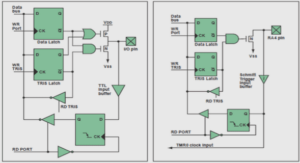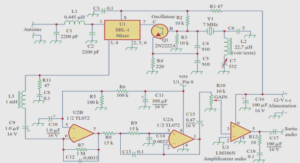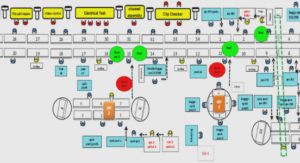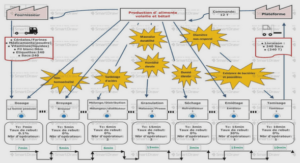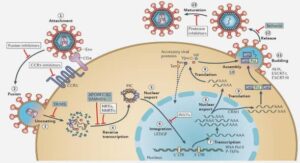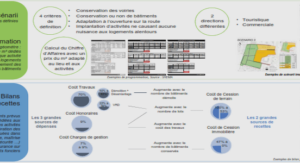Hypoxia in the highly turbid Gironde estuary, applying a 3D model
Study area
The Gironde Estuary is located in Southwest France on the Atlantic Coast, near the city of Bordeaux. It is formed by the confluence of the Garonne River (65% of the freshwater input) and the Dordogne River (35% of the freshwater input) and drains a watershed of 81 000 km² (Figure III.1). It is the largest European estuary, with a surface area of 635 km². The Gironde Estuary is shallow, with a depth range from 5 to 8 m in the upper estuary (upstream of PK25) and a depth of up to 20 m in the lower estuary (downstream of PK25) and near the mouth (Sottolichio and Castaing, 1999). The annual mean river flow is 680 m3 s -1 (sum of Garonne and Dordogne Rivers calculated over the last 10 years (2005-2014); Jalón-Rojas et al., 2015). According to Allen (1972), the Gironde is a partially mixed to well-mixed macro-tidal estuary. The tidal amplitude at the mouth varies from 2.5 m at neap tides (NT) to 5 m at spring tides (Allen et al., 1980). The tidal wave propagates up to 180 km from the estuary mouth to La Réole on the Garonne River (PK-70, 95 km from the river confluence) and to Pessac-sur-Dordogne on the Dordogne River (90 km from the river confluence). The residence time of water in the estuary ranges from 20 to 86 days, depending on the fluvial regime (Jouanneau and Latouche, 1981). Chapitre III: Impact of urban effluents on summer hypoxia in the highly turbid Gironde estuary 100 Figure III.1: The Gironde Estuary in Southwest of France. The distance is noted by kilometric points (PK), with PK100 the mouth and PK-70 the upstream limit. Red points represents water quality monitoring station, with PK4 the location of Bordeaux station. The area in orange represents the area of Bordeaux where the biogeochemical fluxes are calculated. The purple line represents the 200 m isobath. In the TMZ, the suspended sediment concentration (SSC) in the surface waters varies between 0.1 and 10 g L-1 . The particle residence time is estimated to be between 12 and 24 months (Saari et al., 2010). The TMZ migrates longitudinally throughout the semi-diurnal tidal cycle with the ebb and flood currents and throughout the year with river flow variation and a shift in salinity intrusion. In winter, under high river flow, the TMZ is located downstream at Pauillac City, approximately 45 km from the mouth (Doxaran et al., 2009). When the river flow decreases, the TMZ moves upstream, oscillating from the junction of the Chapitre III: Impact of urban effluents on summer hypoxia in the highly turbid Gironde estuary 101 two rivers (Bec d’Ambes) to Portets on the Garonne River and to Libourne on the Dordogne River, i.e., 100 km from the mouth (Castaing and Allen, 1981) (Figure III.1). The vertical distribution of the SSC is controlled by the tide. At slack water, mainly at neap tides, suspended matter settling occurs and an anoxic fluid mud appears at the bottom, forming elongated patches with concentrations greater than 100 g L-1 (Abril et al., 1999). The particulate organic carbon (POC) content in the TMZ is relatively constant at 1.5%, with the major constituent being refractory soil material (90%) with smaller contributions of biodegradable litter and autochthonous phytoplanktonic material (Etcheber et al., 2007). The sewage system of Bordeaux City, located on the Garonne River (Figure III.1), drains an urban area of 578 km² and services an estimated population of 749,595 in 2015. There are two large wastewater treatment plants that discharge treated water comprised mainly of ammonia, and 9 sewage overflows that discharge untreated water mainly consisting of POC (Figure III.1) (Lanoux, 2013). To understand the dynamics of the TMZ and the variation in DO, continuous water quality monitoring systems were installed at Pauillac, Portets and Libourne in 2004 and at Bordeaux in 2005 (Figure III.1). These stations contain real-time systems (updated every 10 minutes) that measure 4 parameters: temperature, salinity, turbidity and DO, and continue to collect data to the present time (Etcheber et al., 2011). The values recorded between January 2005 and October 2006 (http://www.magest.u-bordeaux1.fr) were used in the current study to validate the numerical model, which will be explained in more detail in section III.2.5.
Hydro-sediment model
The SiAM-3D (Simulation for Multivariable Advection) model was initially developed to simulate the dynamics of estuarine suspended sediment and associated biogeochemical variables. A detailed description of the sediment transport model and its first application can be found in Brenon and Le Hir (1999) for the Seine Estuary and in Cugier and Le Hir (2002) for the Bay of Seine. The hydrodynamics model solves the Navier-Stokes set of equations (momentum, continuity and state equations) under the Boussinesq approximation and the hydrostatic assumption in the vertical direction. External and internal modes are separated to solve the set of equations. The external mode determines the free surface elevation and depth-integrated velocity (U and V) from the 2D St- Chapitre III: Impact of urban effluents on summer hypoxia in the highly turbid Gironde estuary 102 Venant equation. Then, the free surface elevation is introduced into the internal modes to determine the three velocity components (u, v, w). The turbulent model uses the eddy viscosity concept based on mixing length theory. The damping of turbulence by density stratification is taken into account by empirical functions using a Richardson number. The transport mode solves the advection/dispersion equations for the dissolved and particulate variables, i.e., salinity, suspended sediment and biogeochemical variables. The equation for suspended sediment accounts for the main cohesive sediment processes: erosion, deposition, flocculation, consolidation and hindered settling (Appendix Table A1, Van Maanen and Sottolichio, 2013). The deposition flux is calculated using the Krone (1962) formulation, and the erosion flux, by the Partheniades (1965) formulation (Appendix Table A1). 2.3.Biogeochemical model The biogeochemical model is based on the model previously developed by Thouvenin et al. (1994) for the Loire Estuary. The biogeochemical model is fully coupled to the SiAM-3D hydrodynamic and sediment transport model and simulates biogeochemical processes that produce or consume oxygen in the water column. These biogeochemical processes include the degradation of organic carbon (POC and DOC), nitrification, photosynthesis, respiration and mortality of phytoplankton, and DO gas exchange with the atmosphere (Figure III.2). For each layer and grid cell, the time evolution of each model variable (C) is the sum of conservative advection, diffusion and sinking processes (𝜑𝑪) and biogeochemical rate processes (𝛽𝑪, Appendix Table A2): 𝜕𝑪 𝜕𝑡 = − 𝜑𝑪 + 𝛽𝑪 + 𝑆𝑪 with 𝜑𝑪 = 𝜕(𝑢𝑖𝑪) 𝜕𝑥𝑖 − 𝜕 𝐾𝑖 𝜕𝑪 𝜕𝑥𝑖 𝜕𝑥𝑖 where C is the variable concentration, 𝑆𝑪 the external input, 𝐾𝑖 is the turbulent diffusivity coefficient, and ui is the current in the 𝑥𝑖 direction with i = x, y or z. Chapitre III: Impact of urban effluents on summer hypoxia in the highly turbid Gironde estuary 103 The dissolved variables are advected and diffused similarly to salinity. The particles settle and can be re-suspended similarly to suspended sediment. The model includes 11 state variables (Figure III.2): dissolved oxygen (DO), ammonia (NH4 + ), nitrate (NO3 – ) and particulate and dissolved organic carbon (POC and DOC) from the watershed and wastewater. For the watershed sources, the model includes the POC from litter (POClitter), which is the biodegradable fraction of terrestrial POC eroded from the Garonne and Dordogne watersheds (Etcheber et al., 2007; Veyssy, 1998), and the DOC from rivers (DOCfluvial) (Veyssy, 1998). For wastewater, the model includes the POC and DOC from wastewater treatment plants (POCWWTP and DOCWWTP) and from sewage overflows (POCSO and DOCSO) (Lanoux, 2013). The model also considers POC from phytoplankton (POCphytoplankton) and detritus (POCdetritus) (Etcheber et al., 2007; Lemaire, 2002; Lemaire et al., 2002). Modifications from the previous version of the biogeochemical model were introduced to include photosynthesis and nitrification processes and to differentiate the degradation rates of organic matter from rivers and urban watersheds. The organic carbon mineralization rates are derived from experimental data obtained using material from the Garonne watershed (litter, 𝑘𝑃 𝑙𝑖𝑡𝑡𝑒𝑟 ; fluvial, 𝑘𝐷 𝑓𝑙𝑢𝑣𝑖𝑎𝑙), phytoplankton (𝑘𝑅 and 𝑘𝑃 𝑑𝑒𝑡𝑟𝑖𝑡𝑢𝑠) (Etcheber et al., 2007; Lemaire, 2002) and the Bordeaux sewage network for WWTP (𝑘𝑃 𝑊𝑊𝑇𝑃 and 𝑘𝐷 𝑊𝑊𝑇𝑃) and SO (𝑘𝑃 𝑆𝑂 and 𝑘𝐷 𝑆𝑂) (Lanoux, 2013). These organic carbon mineralization rates account for the high lability of material from urban effluent and for the more refractory character of organic carbon from the watershed (Lanoux, 2013; Lemaire et al., 2002; Appendix Table A4). In addition, the boundary conditions of each biogeochemical variable are derived from in situ data obtained (in the previous years) from the Garonne and Dordogne Rivers, the Gironde Estuary, and the sewage network of the city of Bordeaux (Table III.1). Phytoplankton primary production is limited by nutrient availability (𝑓(𝑁)) and light attenuation (𝑓(𝐼)) in the water column due to turbidity (Irigoien and Castel, 1997), and we account for preferential uptake of ammonia vs nitrate (𝛼𝑁) (Appendix Table A3). The molar C/N (Appendix Table A4) ratio of organic matter, which controls the relative rates of organic carbon mineralization and ammonification, is set to 10 for litter and wastewater (Middelburg and Herman, 2007) and to the Redfield value of 6 for phytoplankton. The nitrification of NH4 + consumes 2 moles of DO, giving 1 mole of NO3 – . (Appendix Table A4). The formulation of the gas exchange rate (𝑘𝑎𝑒𝑟𝑎, Appendix Table A3) is derived from floating chamber measurement of the CO2 flux Chapitre III: Impact of urban effluents on summer hypoxia in the highly turbid Gironde estuary 104 in the Gironde Estuary (Abril et al., 2009) and takes into account the magnitude of the current velocity, wind, the surface area of the estuary (fetch effect) and SSC (turbulence attenuation).

